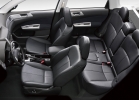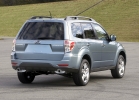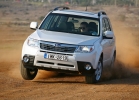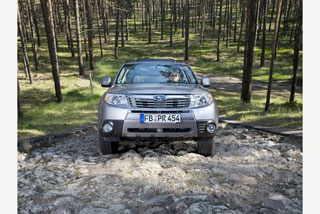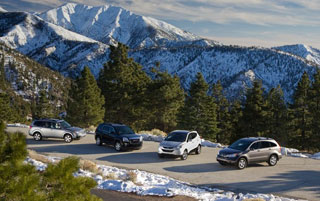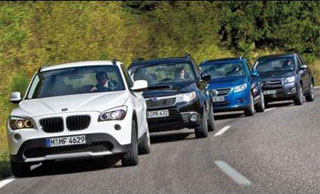Subaru Forester test drive since 2008 SUV
Review of the new generation Subaru Forester
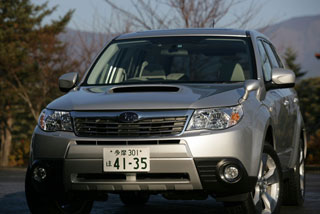 Why did it take for Forester more to resemble SUV?
Why did it take for Forester more to resemble SUV? What has all this time all this time has been allocated by Subaru Forester. I think that I will not be mistaken if I highlight the two main distinguishing features: a relatively small height and a box -shaped body. Many, however, believed and believed that the signs noted by me cannot be considered decisive, but should be treated with a kind of shortfall inherent in models in the stage of formation. Well, let it be so, the essence of the matter does not change from this. Indeed, one way or another, but these same deficiencies ultimately determined the former image of Forester. This was equally related to first -generation machines (I remind you that Forester's debut came in 1997), and to the 2002 model models. In the first and second cases, Forester had too energetic in order to be called a simple universal such as Station Wagon or a representative of the SUV class. Therefore, there was only one to classify it as a mixed -type car. Like, let him stay with the crossover so far, and there we will see!
But why will we see where such uncertainty and uncertainty come from? Do you think with what kind of car the expression of the Subaru brand crossover is associated? I am sure that the vast majority will answer, of course, with Subaru Outback, which whether you want it or not, turned out to be in the role of the discoverer, and this is a failed fact. Well, and why, tell me mercy, confuse cards and confuse buyers, offering them another mixed -type car? Of course, it has a certain personality, but to be honest, the similarities between them are still more, and they claim (more precisely, claimed) they are the same place in the market.
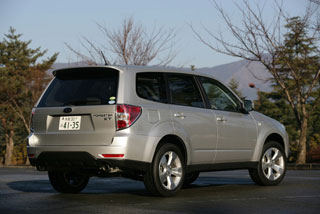 In this situation, the most correct decision is to leave the Outback crossover alone and proud loneliness, and Forester, taking advantage of the fact that the time has come to complete replacement of the lineup, urgently re -qualify it to traditional SUV. As you can see, they decided on this.
In this situation, the most correct decision is to leave the Outback crossover alone and proud loneliness, and Forester, taking advantage of the fact that the time has come to complete replacement of the lineup, urgently re -qualify it to traditional SUV. As you can see, they decided on this. Yes, so many will say, indeed, have decided! If, for example, take and deprive the new car of its branded 6-star emblem, it is unlikely that anyone will guess that there is nothing more than the new Forester model! Indeed, this is so, especially if we take into account that the current Forester is no longer so low, and the body is now deprived of the previous angularity. By the way, about the height: if you measure the car without decorative rails on the roof, it turns out that compared to the previous model, the full height increased by 85 mm, and if you compare cars with the rails, then at all by 110.
A 2-liter engine is very economical even with a turbine
In addition to the height, the car added both in length and in width (respectively, by 75 and 45 mm). But here's what is curious: in practice, you do not feel at all that the new Forester is larger than its predecessor. Although what is there to be surprised if, the smallest radius of the turn even decreased (by 20 mm, by the way!), Plus, the distance between the extreme outer points of the left and right door mirror has become smaller by a whole centimeter. It is clear that in this situation, maneuvering, going around the roads on the road, became easier. Here you have an increase in size!
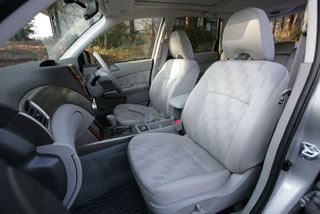 We look further: the wheelbase increased by 90 mm, and almost the entire increase went to increase the length of the cabin, or, more precisely, to increase the distance between the front and rear seats. But this is not surprising, given that the main market for Forester cars is North America, where, as you know, not the lowest people in the world live. At the same time, such a nuisance as a rapid increase in fuel did not pass by the Americans. There is no time for gigantomania! So it turns out that the desire to spent as little as possible on the car prompts drivers to transfer to compact cars. And all would be nothing, but only previous habits still make themselves felt. In particular, they demand that the back in the car still would not be so crowded, and in which case an adult passenger, and not just a child could have accommodated there. My height, by the way, is 168 cm. So, if you look from the height of my height, then the back seat can be called quite convenient and spacious, my head was not close either, in a word, even a fertile (in moderation, of course) the client should be satisfied .
We look further: the wheelbase increased by 90 mm, and almost the entire increase went to increase the length of the cabin, or, more precisely, to increase the distance between the front and rear seats. But this is not surprising, given that the main market for Forester cars is North America, where, as you know, not the lowest people in the world live. At the same time, such a nuisance as a rapid increase in fuel did not pass by the Americans. There is no time for gigantomania! So it turns out that the desire to spent as little as possible on the car prompts drivers to transfer to compact cars. And all would be nothing, but only previous habits still make themselves felt. In particular, they demand that the back in the car still would not be so crowded, and in which case an adult passenger, and not just a child could have accommodated there. My height, by the way, is 168 cm. So, if you look from the height of my height, then the back seat can be called quite convenient and spacious, my head was not close either, in a word, even a fertile (in moderation, of course) the client should be satisfied . The main determining moment of the new Forester car is the Si chassis, which is already used in the new generation Impreza machines. The front wheels are suspended to the chassis through the racks of MacPherson, the rear through double transverse levers. Both the front and the back suspension have an increased working move, it is also unnecessary to say that before putting on the new Forester, the suspension was redeemed accordingly.
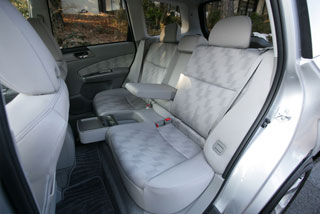 In service with an updated model is a 2L series of two varieties with atmospheric and turbocharged inlet. First, I will dwell on the characterization of the motor with a simple inlet. The main feature is the appearance of another distribution shaft in the gas distribution mechanism. So now it is no longer SOHC, as it was before, but DOHC. What did it give? Its capacity increased by 8 horses, it has become more by 0.5 kg-m and torque. Moreover, which is characteristic: the peak of torque is shifted towards the smaller speed of the crankshaft (now it is 3,200 rpm, and earlier it was 800 rpm larger). It is easy to understand that this is done, including so that the car feels better at small and medium speeds. Now let's turn to a turbocharged engine with an intermediate cooler supplied to the air cylinders. He has a new cylinder head, a new intermediate cooler and a new turbine. Plus, the inlet collector made of carbon fiber. All these innovations made it possible to increase the engine power by 10 hp, and the torque by 1.0 kg-m. And in the end, the rated power began to equal 230 horsepower forces (the peak occurs at a rotation frequency of 5,600 rpm), and the largest torque is now 32.5 kg-m (2,800 rpm). Regardless of the engine, the car can go both with a 4-speed automatic and with a 5-speed manual. As for the fuel consumption, for example, in the control mode of 10/15, a car with an atmospheric engine for 100 km of run consumes 7.2 liters (on a furry) or 7.1 liters (with an automaton). As for the car with a turbocharged engine, regardless of the type of transmission, its consumption was 7.7 liters per 100 km, which, you see, very, very good, especially for turbo.
In service with an updated model is a 2L series of two varieties with atmospheric and turbocharged inlet. First, I will dwell on the characterization of the motor with a simple inlet. The main feature is the appearance of another distribution shaft in the gas distribution mechanism. So now it is no longer SOHC, as it was before, but DOHC. What did it give? Its capacity increased by 8 horses, it has become more by 0.5 kg-m and torque. Moreover, which is characteristic: the peak of torque is shifted towards the smaller speed of the crankshaft (now it is 3,200 rpm, and earlier it was 800 rpm larger). It is easy to understand that this is done, including so that the car feels better at small and medium speeds. Now let's turn to a turbocharged engine with an intermediate cooler supplied to the air cylinders. He has a new cylinder head, a new intermediate cooler and a new turbine. Plus, the inlet collector made of carbon fiber. All these innovations made it possible to increase the engine power by 10 hp, and the torque by 1.0 kg-m. And in the end, the rated power began to equal 230 horsepower forces (the peak occurs at a rotation frequency of 5,600 rpm), and the largest torque is now 32.5 kg-m (2,800 rpm). Regardless of the engine, the car can go both with a 4-speed automatic and with a 5-speed manual. As for the fuel consumption, for example, in the control mode of 10/15, a car with an atmospheric engine for 100 km of run consumes 7.2 liters (on a furry) or 7.1 liters (with an automaton). As for the car with a turbocharged engine, regardless of the type of transmission, its consumption was 7.7 liters per 100 km, which, you see, very, very good, especially for turbo. 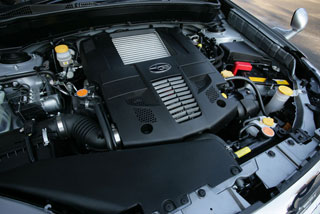 By the ability to keep the body, Forester surpassed the Impreza model
By the ability to keep the body, Forester surpassed the Impreza model So, a new appearance and interior, a new chassis and a power transmission all this is a new generation Forester. But only how to make an idea with maximum completeness and accuracy about how all these innovations were reflected in the behavior of the car? I’m not sure that the most right path is immediately driving a car of the most expensive category, but this time it happened that way. And so I go to the Forester 2.0 XT car, open the door and sit in the driver's seat. Before me is a wide front panel that is already familiar to me. Well, of course, there can be no doubt that is an almost accurate copy of the panel in the Subaru Impreza salon. Only this time, due to the fact that I look at her at a large angle, it turns out to be a little lower, and a wide panorama of the road opens in front of me. And immediately there is a feeling of freedom and relaxedness.
Okay, I'm touching and starting to move leisurely. The car seems extremely convenient and comfortable to me, I simply did not expect this from it. I remember that exactly the same surprise I survived when meeting Impreza S-GT. Yes, I thought right away, I don’t know how it will go further, but as for the everyday driving, when you disperse, you slow down, and so constantly, the presence of the Si-chassis really affects. And, say, the behavior of the body at high speed, because this is just a class! Let me explain what I mean: the road clearance, frozen at the extreme lower point, is quite large for 225 mm. It is clear that the workshop of the suspension is also pleased with a large one. But despite this, the body holds surprisingly directly and evenly relative to the surface of the road, as if something presses on top of it. You know, I was delighted about this when I experienced a new generation Impreza car, and did not expect Forester to make an even greater impression on me. Unbelievable, but it is a fact!
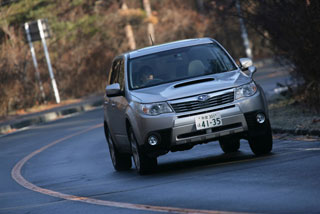 The 2L turbo engine, which was made so that it was easy to drive in the usual mode (let's call it with practical driving), is able to give a decent torque already starting from low speeds. And when the speed of the crankshaft rotates for 2,000 rpm, the car seems to open a second wind, and then it is not difficult to rush forward for it at all, no matter what its initial speed will be. And only somewhere after 5,000 rpm the motor is somewhat surrendered, but, nevertheless, continues to demonstrate sufficient acceptance.
The 2L turbo engine, which was made so that it was easy to drive in the usual mode (let's call it with practical driving), is able to give a decent torque already starting from low speeds. And when the speed of the crankshaft rotates for 2,000 rpm, the car seems to open a second wind, and then it is not difficult to rush forward for it at all, no matter what its initial speed will be. And only somewhere after 5,000 rpm the motor is somewhat surrendered, but, nevertheless, continues to demonstrate sufficient acceptance. Actually, if we talk about acceptance, then the driver has the opportunity to choose various options, for which the SI-Drive control system serves. If you want the car to rush forward headlong, the Sport Sharp mode is turned on, if you still want to somehow control this unbridled splash of energy, then you should set the Sport mode. It’s easier not to experiment at all, but simply to move in Intelligent Mode, and that’s all. I just want to note that no matter what mode it turned on, I never felt that the engine showed signs of overstrain.
I was lucky: after a trip by Forester XT (that is, with turbocharged), I immediately moved behind the wheel of XS with an ordinary engine to compare what and how. So what did I find out? The engine without a turbine, of course, cannot boast of such an excess of torque, and it makes no more noise, no doubt. But the car moves forward quite energetically, is this the main thing?
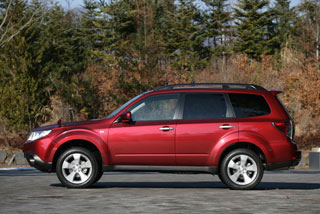 The same Impreza, only with a wagon body
The same Impreza, only with a wagon body Do you know what came to my mind and inevitably followed me all the time, while I tried first one, then another new generation Forester model? That at the current prices these cars are certainly worth the money that they ask for them. At the same time, note, I still do not take into account the fact that the new Forester has become, in fact, the full representative of the SUV category, but simply compare the sale price and, so to speak, the consumer value of the purchased goods. And in this regard, the Forester XT model, equipped with a turbo engine, appeared especially balanced to me. I am not even embarrassed by the fact that for this car the buyer will have to put on 350 thousand yen ($ 3,300) more than for his unhurged fellow Forester XS. Anyway, it seems to me that the game is worth the candle. Moreover, these two machines have almost the same fuel consumption, so in terms of cost of operation everything seems to converge.
Well, good, what's next? And then, no matter how strange it may seem, I would like to propose to compare the two Forester and Impreza cars, especially since I have repeatedly paid the attention of readers to some similarities between these models. So, on the one hand, Forester XT will cost the buyer a little more, and this is true. But on the other hand, let's first compare the luggage compartment of Impreza and Forester trunk to feel the difference in terms of the load capacity of the first and second. Then, probably
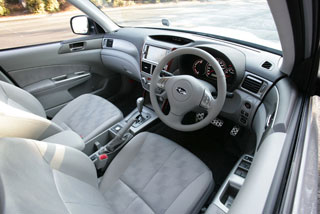 it should be remembered that the back of the Forester salon leans not only forward, but also back, but also that for this it is not necessary to climb into the salon, but you can use a special pen located next to the trunk door. In practical terms, this is an indisputable plus, right? What else? Forester is equipped with a target stability system, the salon is equipped with three -point seat belts, and they are not only in front, but also from behind. The same applies to active head restraints. Doesn't all this suggest that it is more correct to pay a little more and take a new Forester instead of Impreza? I believe that yes, especially if you are rather big growth, which does not allow you to feel completely at ease in the Impreza salon. Ah, you are crowded in the Impreza hatchback salon? Then I advise you to take Forester, because this is practically the same Impreza, only with the wagon body!. Now, I hope, it is clear what is my essence, so to say, discoveries?
it should be remembered that the back of the Forester salon leans not only forward, but also back, but also that for this it is not necessary to climb into the salon, but you can use a special pen located next to the trunk door. In practical terms, this is an indisputable plus, right? What else? Forester is equipped with a target stability system, the salon is equipped with three -point seat belts, and they are not only in front, but also from behind. The same applies to active head restraints. Doesn't all this suggest that it is more correct to pay a little more and take a new Forester instead of Impreza? I believe that yes, especially if you are rather big growth, which does not allow you to feel completely at ease in the Impreza salon. Ah, you are crowded in the Impreza hatchback salon? Then I advise you to take Forester, because this is practically the same Impreza, only with the wagon body!. Now, I hope, it is clear what is my essence, so to say, discoveries? Now let's go from another side and look at Forester not as an addition to the Impreza modeling row, but as for the next SUV car. I don’t know how, how, but personally it seems to me that with the final transition to this class, the car lost part of its individuality, and this is made a little sad. Well, okay, there is nothing to cling to the past, it is better to see how all this will turn out in the future. It should be noted here: where Forester is so striving, they are waiting (more precisely, they are not waiting for him at all!) The competitors of Toyota Rav4 and Nissan X-Trail in excellent shape. Surviving in such a company is not at all easy, but if this happens, the status of Forester in the eyes of customers, of course, will grow. But really, why not? After all, the new Forester is still a well-designed car, so why don't he stand on a par with the popularity of SUV cars that have already gained popularity? Well, the future will show, we just have to wait a bit, carefully tracking all the vicissitudes of his upcoming struggle.
Technical characteristics Subaru Forester 2.0 XT
Full length: 4 560 mm.
Full width: 1 780 mm.
Complete height: 1 675 mm.
Wheel base: 2 615 mm.
Machine weight: 1,480 kg.
Drive: 4wd.
Engine: 2-liter, 4-cylinder with horizontal cylinders, turbocharging with an intermediate air cooler, DOHC gas distribution mechanism, developed power 169 kW (230 hp) at 5,600 rpm, maximum torque 32, the moment 32, 5 kg-m (319 nm) at 2 800 rpm.
Transmission: 4-speed automatic.
Machine price: 2 572 500 yen ($ 24 166).

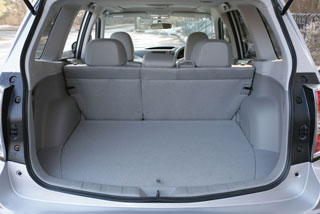
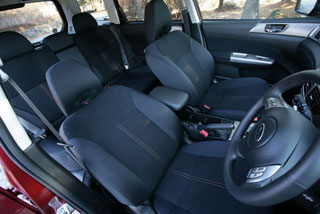
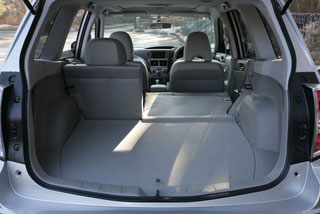
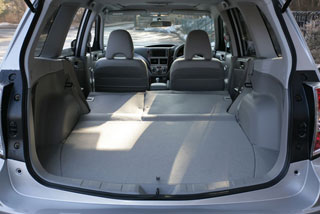
Source: CarView.co.jp
Video Subaru Forester test drive since 2008
Subaru Forester Crash Video since 2008
Subaru Forester test drive since 2008
Subaru Forester Crash Test since 2008
Krassh Test: Detailed Information91%
Driver and passengers
73%
Pedestrians
91%
Children-passengers
86%
Active security system


